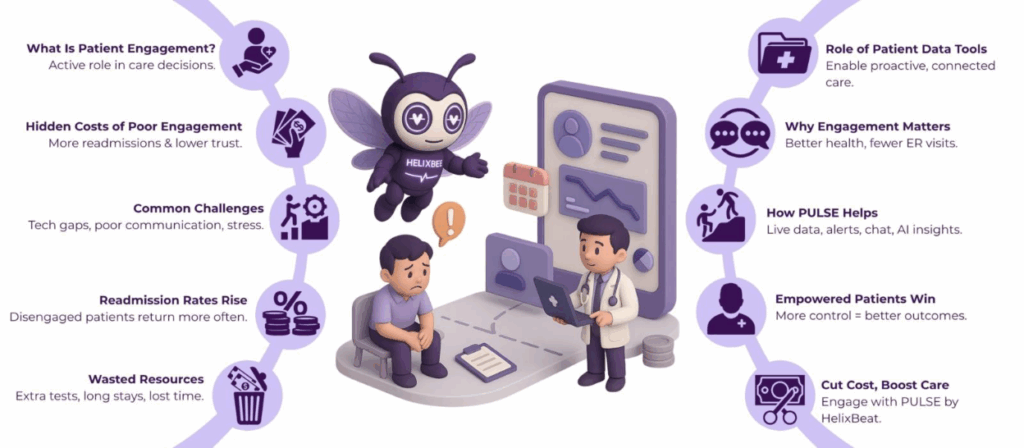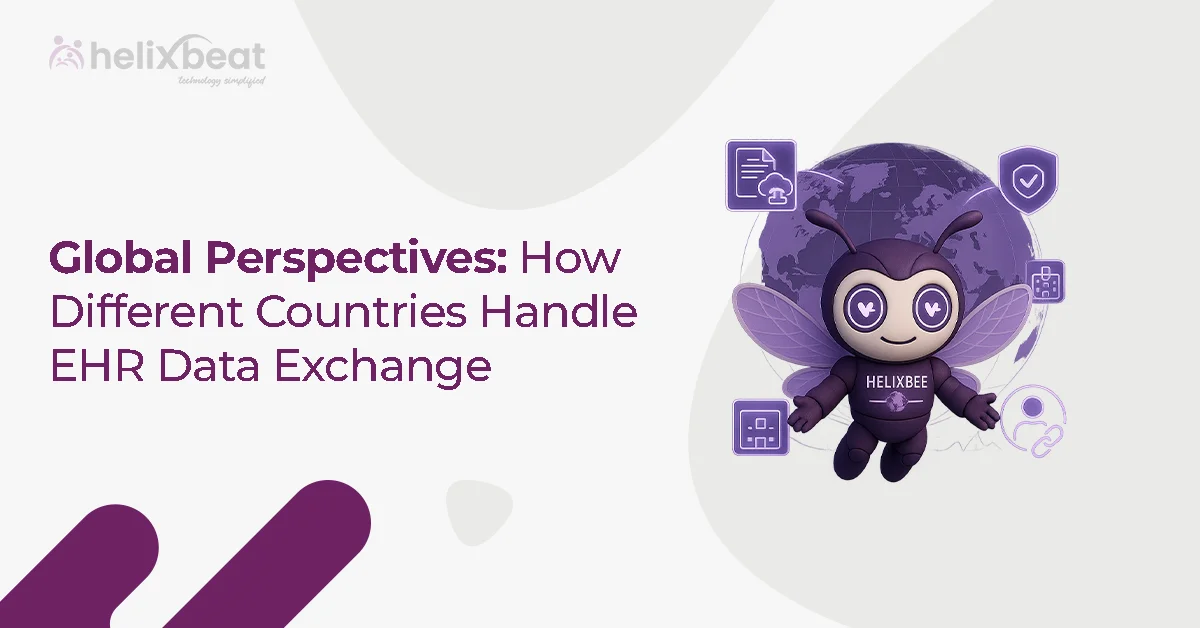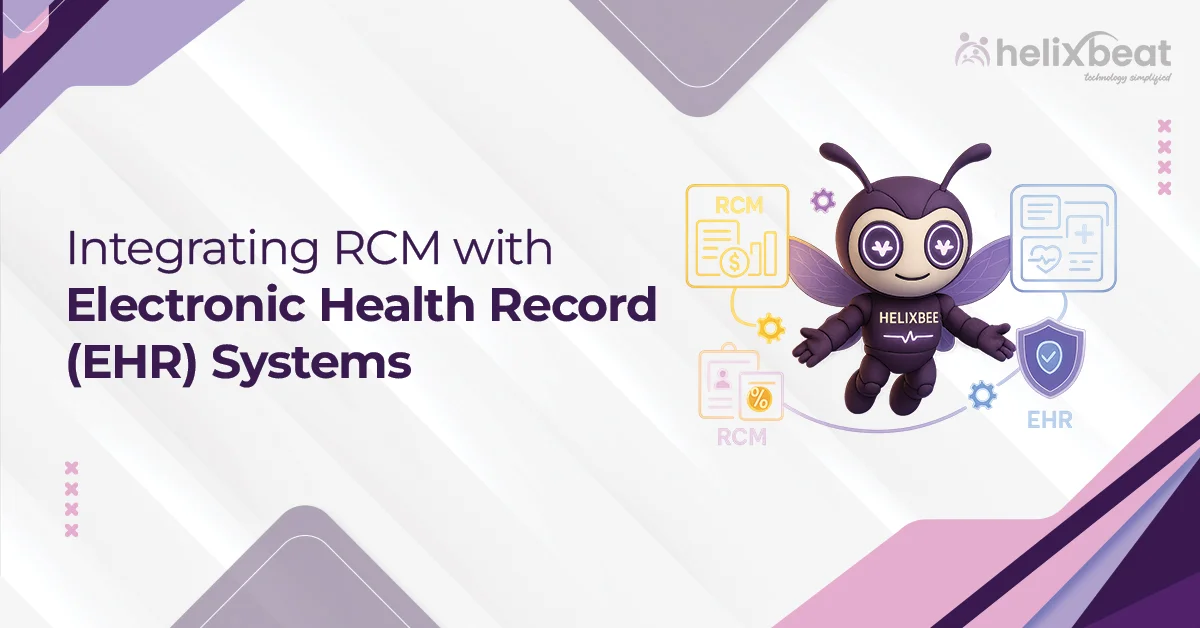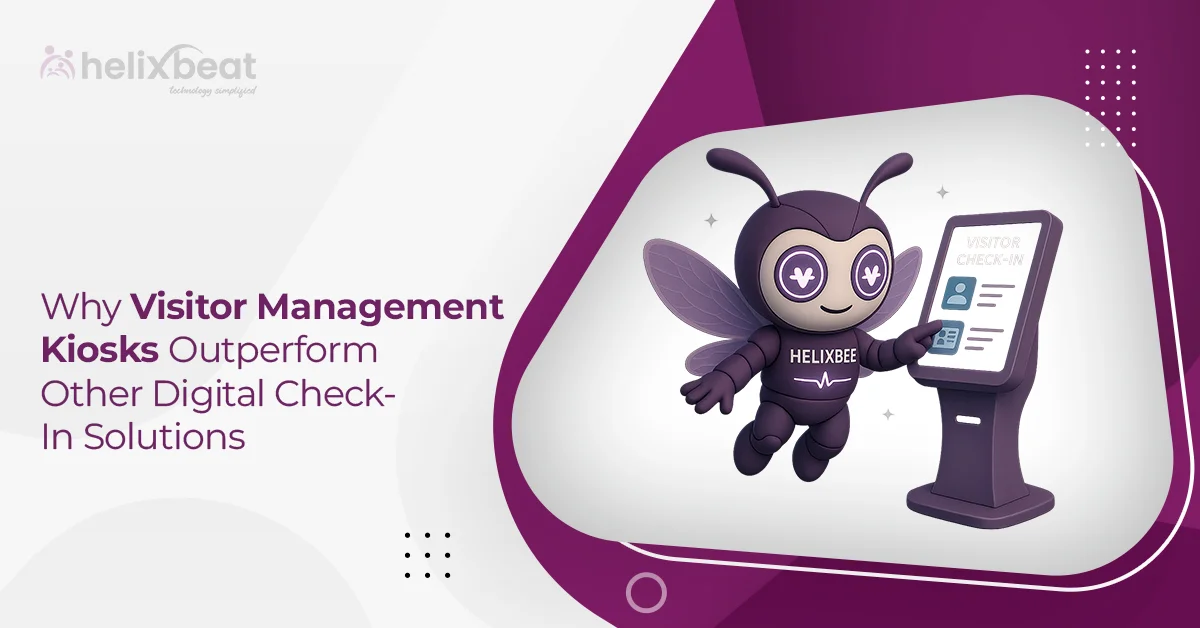Poor patient engagement in healthcare settings can have a far-reaching impact, not only on patient outcomes but also on healthcare costs and expenses. Engaging patients in their care has been shown to reduce unnecessary readmissions and improve treatment adherence. According to research by Zynx Health, improving patient engagement, particularly through effective discharge planning and caregiver involvement, can lead to a 25% reduction in readmissions within 90 days.
These findings underscore the critical role of patient engagement in enhancing healthcare quality and reducing unnecessary expenditures. In this blog, we’ll explore the hidden costs of poor patient engagement, challenges, and solutions such as patient data management systems to improve patient engagement healthcare.

Table of Contents
What is Patient Engagement in Healthcare?
Patient engagement in healthcare refers to the active involvement of patients in their care process, which includes decision-making, managing their health conditions, and maintaining an open line of communication with healthcare providers. Effective patient engagement is crucial for ensuring better health outcomes and more personalized care.
An essential component of patient engagement is the ability for patients to access and manage their health information easily and effectively. This is where PULSE by HelixBeat plays a critical role. It is a platform that enables healthcare providers to seamlessly engage with patients by giving them access to real-time health data, enhancing communication, and facilitating proactive care management. Key Points:
Patient Engagement: This involves patient education, participation in treatment decisions, and effective communication with healthcare providers. With PULSE, healthcare providers can offer easy access to patient data, facilitating discussions between patients and their care teams.
Outcome Improvement: Better engagement, supported by tools like PULSE, leads to improved health outcomes, fewer complications, and reduced hospital readmissions by enabling proactive management of health conditions.
The Hidden Cost of Poor Patient Engagement
When patients aren’t actively involved in their healthcare, it can lead to serious problems. Hospitals often see a higher number of patients returning after discharge, more extended hospital stays, and increasing healthcare costs. According to a study, approximately 20% of Medicare recipients return to the hospital within 30 days of discharge, resulting in a significant financial burden on the entire healthcare system.
Hidden Costs
Addressing these challenges requires a concerted effort to enhance patient engagement through improved communication, education, and support systems.
- Increased Readmissions
- Patients who are disengaged are more likely to be readmitted, which pushes hospital resources and increases operational costs.
- Lower Patient Satisfaction
- Disengagement negatively impacts patient satisfaction, leading to lower retention rates and the loss of future patients.
- Inefficient Use of Resources
- A lack of commitment can lead to the wasteful use of healthcare resources, including unnecessary tests and prolonged treatments.
What Are the Challenges of Patient Engagement?
Reaching optimal patient engagement in healthcare presents its own set of challenges. Healthcare providers often encounter varied barriers that can hinder patients from taking an active role in their care. These challenges can range from technological limitations to psychosocial factors, making it difficult to foster strong, effective engagement.
Below are some of the key challenges that healthcare providers must address to improve patient engagement:
Common Challenges
- Technological Barriers
- Not all patients have access to the necessary technology, such as smartphones, tablets, or computers, to engage with digital health tools.
- Even when patients do have access to these tools, some may lack the digital literacy required to navigate patient portals, mobile health apps, or telemedicine platforms effectively.
- Connectivity issues in rural or underserved areas can further prevent patients from accessing virtual healthcare services, leading to gaps in engagement.
- Lack of Communication
- Miscommunication between patients and healthcare providers is a common barrier to effective engagement.
- Patients may not fully understand their treatment plans, which can lead to non-compliance or confusion about the next steps in their care.
- Healthcare providers may not always have the tools or time to offer clear, consistent communication, especially in busy practices where patients feel rushed or overlooked.
- The lack of personalized communication, such as failure to explain health conditions in layperson terms, can make patients feel disengaged and less likely to follow through with treatment.
- Psychosocial Factors
- Mental health conditions like anxiety, depression, or cognitive impairment can impact a patient’s willingness and ability to engage with their healthcare. These patients may struggle with motivation or understanding the importance of their treatment plans.
- Cultural beliefs and language barriers can influence how patients perceive their healthcare experience. Patients from diverse cultural backgrounds may have different expectations or reluctance to accept specific treatments, making engagement more complex.
- Socioeconomic factors, such as financial instability or a lack of insurance, can prevent patients from following up on appointments, filling prescriptions, or participating in necessary treatments.
Role of Patient Data Solutions in Enhancing Engagement
Patient data solutions are crucial tools in enhancing patient engagement by helping healthcare providers track, manage, and communicate essential patient information more effectively. These technologies create a seamless connection between patients and healthcare teams, ensuring more personalized, timely, and proactive care.
- Better Communication
- This tool streamlines communication by providing both healthcare providers and patients with access to up-to-date medical records, thereby reducing errors and ensuring patients are always informed about their treatment plans.
- Automatic alerts for appointments, test results, and medication reminders enhance communication between the patient and care team.
- Personalized Care
- By accessing accurate and current patient data, healthcare providers can customize treatment plans to meet the specific needs of everyone.
- Providers can look at a patient’s entire medical history, including past conditions and treatments, which helps in designing effective, targeted care strategies.
- Proactive Engagement
- By utilizing advanced patient data solutions, providers can identify potential health issues before they become critical, enabling timely intervention and ultimately improving patient outcomes.
- These systems enable continuous monitoring of chronic conditions, helping patients stay engagFed and informed about their health, which leads to improved long-term management.
Why is C Engagement Important in Healthcare?
When patients take an active role in their care, they are more likely to experience better health outcomes and participate fully in the treatment process. Engaged patients understand their conditions, follow treatment plans, and are proactive about managing their health, which significantly benefits both them and the healthcare system.
1. Improved Health Outcomes
- Engaged patients are more likely to manage their chronic conditions, such as diabetes, hypertension, and asthma, by adhering to treatment plans and making necessary lifestyle changes. This reduces complications and promotes long-term health.
- Active patient involvement can reduce hospital readmissions, as patients are better prepared for post-discharge care and understand when to seek medical help early.
- Engaged patients contribute valuable information about their health, enabling providers to tailor care plans that are best suited to their individual needs.
2. Cost Reduction
- Engaged patients are less likely to need costly interventions, emergency care, or long-term treatments. This results in lower healthcare costs over time.
- Patients who are engaged and understand the importance of follow-up visits are less likely to miss appointments, which can prevent more expensive treatments and complications down the line.
- With proactive care, unnecessary tests and hospital stays are minimized, leading to a more efficient use of healthcare resources.
See How Patient Engagement Can Transform Your Healthcare System with PULSE
PULSE by HelixBeat : A Key to Effective Patient Engagement
PULSE by HelixBeat is a state-of-the-art patient engagement platform built to tackle the common challenges that healthcare providers face when it comes to patient involvement. Designed with an intuitive interface and robust qualifications, PULSE licenses both healthcare professionals and patients by providing seamless access to real-time health data and insights. With the growing importance of patient engagement in healthcare, PULSE is strategically built to help healthcare providers enhance patient involvement, improve health outcomes, and reduce operational costs associated with poor engagement.
It enables healthcare teams to communicate more effectively, monitor patient progress, and respond to patient needs more quickly, all while ensuring that patients feel involved and informed throughout their care journey.
- Real-Time Patient Data Access
- Both healthcare providers and patients can view and update their health data in real-time, ensuring that critical information is always available when needed.
- All patient records, medical history, prescriptions, and test results are accessible through a secure, cloud-based platform, minimizing the chances of errors or miscommunication.
- Healthcare providers can make faster, data-driven decisions, improving the efficiency and effectiveness of treatments.
- Seamless Communication
- PULSE facilitates seamless, direct communication between healthcare providers and patients. Whether through secure messaging, video consultations, or push notifications, both parties can stay updated and connected.
- Patients are notified of appointments, test results, medication reminders, and any changes to their care plans, ensuring they are always informed and prepared.
- Clear and timely communication fosters trust and boosts patient satisfaction by promptly addressing concerns and reducing wait times.
- AI-Driven Insights
- PULSE uses artificial intelligence to analyze patient data and provide tailored recommendations that optimize individual care plans.
- AI enables healthcare providers to anticipate potential health issues before they escalate, allowing for proactive management of chronic conditions and preventing avoidable complications.
- With machine learning capabilities, PULSE constantly refines its suggestions and insights based on the latest patient interactions and medical advancements.
- Patient Empowerment
- PULSE empowers patients to take control of their healthcare journey by providing self-management tools, including health trackers and progress reports.
- Patients can access resources that help them understand their conditions, treatments, and the importance of adherence, enabling them to take a more proactive approach to their care.
Conclusion
The hidden cost of poor patient engagement is a significant concern for healthcare providers, impacting both patient outcomes and the financial health of the institution. Implementing effective patient data solutions, such as patient data management systems, can enhance engagement and mitigate these costs. With platforms like PULSE by HelixBeat, healthcare providers can bridge the gap between patients and care teams, leading to better health outcomes, improved patient satisfaction, and reduced operational expenses.
Sign Up for PULSE by HelixBeat Today!
FAQs
- What is patient engagement in healthcare?
Patient engagement refers to the involvement of patients in their own healthcare process, including understanding their conditions, participating in treatment decisions, and maintaining communication with healthcare providers.
- Why is patient engagement important in healthcare?
Engaged patients tend to have better health outcomes, fewer hospital readmissions, and lower healthcare costs. Their active involvement leads to improved treatment adherence and satisfaction.
- What are the benefits of using patient data management systems for patient engagement?
Patient data management systems provide real-time access to medical information, enable seamless communication, and allow healthcare providers to deliver personalized care, ultimately improving patient engagement and outcomes.
- How does PULSE by HelixBeat enhance patient engagement?
PULSE provides healthcare providers and patients with real-time data access, facilitates seamless communication, and leverages AI-driven insights to offer personalized care, all of which enhance patient engagement.
- What challenges do healthcare providers face in patient engagement?
Common challenges include technological barriers, communication gaps, psychological and behavioral issues, and a lack of resources or training for effective engagement.
- How does AI improve patient engagement in healthcare?
AI can provide predictive insights, personalized care recommendations, and help healthcare providers proactively address potential health issues, fostering greater patient involvement and improved health outcomes.
- What is the role of patient data solutions in patient engagement?
Patient data solutions allow healthcare providers to access accurate, up-to-date patient information, facilitating personalized care, and empowering patients to make informed decisions about their health.
- What factors contribute to a lack of patient engagement?
Factors such as lack of education, emotional or psychological barriers, financial constraints, poor communication, and inadequate technology access can contribute to patient disengagement.
- How does PULSE improve communication between patients and healthcare providers?
PULSE enables secure, real-time messaging, appointment reminders, and updates, ensuring that both patients and healthcare providers stay informed and engaged throughout the care process.
- Can PULSE integrate with existing healthcare systems?
Yes, PULSE can integrate with existing healthcare data management systems, enabling a seamless transition and ensuring that all patient data is stored securely in one place.
- What impact does patient engagement have on healthcare costs?
Proper patient engagement can reduce costs by lowering readmission rates, improving treatment adherence, reducing hospital stays, and preventing avoidable complications, thus making healthcare more efficient and cost-effective.
- How can I get started with PULSE?
You can start by scheduling a demo to explore how PULSE can transform patient engagement in your healthcare setting. Contact us for more details.














